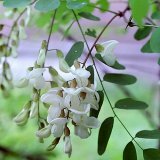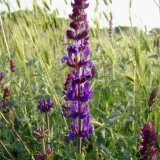Acacia white as a medicinal plant

White acacia is a fairly large tree belonging to the family of legumes;It reaches 15 to 20 meters in height. The trunk is gray-black or gray-brown with characteristic longitudinal cracks. Shoots and young branches are smooth, green. Leaves ovate or longitudinally ovoid, located opposite. On one stalk can be from 7 to 21 leaflets. The top surface of the leaf is smooth, green in color, the lower one is velvety, gray-green in color. The white acacia blossoms at the end of May. White flowers are butterfly type, have a pleasant aroma, form an inflorescence brush. Fruit is a pod. It is flat, dark-brown in color, contains 4-6 bean-shaped seeds. The latter ripen in June. Prepare flowers during the flowering period, beginning from the end of May and beginning of June. Collection of leaves and bark is carried out throughout the growing season. Used acacia white as a medicinal plant.
Acacia plant is widespread in North America, acclimatized and successfully growing in the southern regions of Russia. It occurs in parks, gardens, near roadsides and railways. The name Robinia was given by Karl Linnaeus in honor of the gardener King Louis XII of Vespasian Robin. The popular name "white acacia" has no scientific justification. This plant has never belonged to the genus Acacia, but is a representative of another genus - robinia. Confusion in terminology arose, most likely, because "acacia" in Greek means "thorn".Due to the fact that the leaves of this plant are similar to flames, it is believed that it was the white acacia that lit, but did not burn when the Angel appeared to Moses. In Mediterranean countries acacia in bloom is a symbol of platonic love and friendship. It is assumed that it was from the branches of the acacia that the crown of thorns was woven.
It is believed that acacia white has a very powerful energy, therefore, from pieces of its wood, amulets are produced that have protective properties.
Composition of the plant.
The active substances of acacia white are essential oils that contain methylantranilate, heliotropin, tannins and esters of salicylic acid found in its flowers. Flavonoids and their glycosides are found in the leaves: acacia, acacetin, robinin. The bark of young shoots and wood is rich in tannins, fatty oils, stigmasterol, phytosterol, and also toxic robinin.
Application of acacia white.
The plant is planted on the slopes of ravines and along a railroad track to strengthen the slopes. In perfumery, scented oil, made from flowers, was widely used. The wood of this plant is considered a good finishing material, and the acacia itself is a good honey. Medicinal raw materials are leaves, flowers, bark of young shoots.
Traditional medicine recommends using this medicinal plant as an antispasmodic, expectorant, choleretic, diuretic, antipyretic. In Europe, it is used as an expectorant and a laxative.
Alcoholic infusion from the leaves of white acacia and its young shoots is prescribed for exacerbation of peptic ulcer and gastritis. These same diseases are treated with a hot decoction of the acacia bark.
However, white acacia, in addition to therapeutic components, contains toxic ingredients, for example, the alkaloid robinin. In this regard, you should strictly follow the dosage and recommendations for the manufacture and use of drugs.
Attention, take medications from acacia white only on the advice and under the supervision of doctors!
It should be noted that when harvesting wood, acute poisoning can occur, which is expressed in nausea and vomiting, malaise, drowsiness, headache.
Folk recipes with white acacia.
Recipe 1. Decoction of flowers. To prepare the broth, you can use fresh or dry( 1 tbsp.) Acacia flowers. Brew them half a liter of boiling water and boil for three minutes. Then filter and bring the volume to 0.5 liters. Eat 20 minutes before eating 1 tablespoon three times a day. Applied with uterine myomas and various inflammatory sexual diseases in women.
Recipe 2. Decoction from the bark. To prepare the broth, take 0.5 tablespoon of bark, grind it and brew in 0.5 liters of boiling water. Then put the mixture to boil on a small fire for 20 minutes. Filter still hot, bring the volume to 0.5 liters. The broth should be used within two days. If you feel well, you can drink a cooked decoction in one day. Applied with stomach ulcer and exacerbation of gastritis.
Recipe 3. An infusion of white acacia flowers, used in diseases of the kidneys, bladder and urolithiasis. Take 1 tablespoon of acacia flowers and brew it with a glass of boiling water. Infuse the infusion for half an hour. Take 1/3 cup after eating three times a day.
Recipe 4. Vodka tincture. To prepare tinctures, it is necessary to mix leaves and young shoots of acacia and pour them with vodka in the proportion 1:10.The solution should be insisted for 15 days, without forgetting to periodically shake. The received tincture is taken one teaspoon before meals three times a day for various digestive disorders.
Recipe 5. Tincture of leaves or flowers. Flowers or white acacia leaves should be poured 70 ° alcohol in a ratio of 1: 2.This tincture is used externally for grindings, lotions and compresses with such diseases as rheumatism, thrombophlebitis, neuralgia, osteochondrosis, sciatica, myositis, as well as with colds and inflamed wounds. Tincture is able to dissolve blisters of venous nodes.
In the treatment of gastric ulcers and gastritis in the acute stage, use a tincture of leaves and young shoots or a hot decoction of the acacia bark white.



